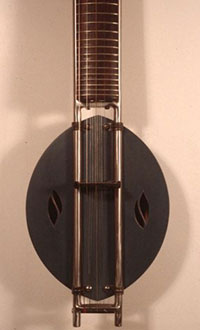The grant provided the funds needed to buy both books for my research and the materials for the instrument, and also allowed me some time to focus closely on the project. I ended up producing both an instrument and a research paper, and the work was incredibly important in the formation of my current career.

The “anole,” an instrument designed by SOM alumnus Jeff Snyder.
The instrument I built was called the Anolé, after the color-changing lizard. I wanted to design a stringed instrument that had removable fretboards so that it could perform music written in multiple tuning systems besides equal temperament. I was strongly influenced by Harry Partch’s “Genesis of a Music,” a classic text in the field which was actually written at UW-Madison in 1947. Since my wood and metal-working skills were lacking at the time, I formed a collaboration with Visual Arts MFA student Don Miller (now an Associate Professor at the University of the Arts in Philadelphia). This collaboration taught me woodworking skills that have been incredibly useful in my professional life since. The instrument turned out to be very successful, and I used it in performance for the next two years. There were several problems with its design, however, and searching for solutions to these problems eventually led me down the research path I follow to this day.
The paper I wrote was related to the same research, but focused on the tuning of bar percussion instruments. It was called “Development of a Useful Scale Based on Inharmonic Bar Partials.” The research for the paper was primarily inspired by ideas presented in the book “Tuning, Timbre and Scale,” by William Sethares, a professor in the Electrical and Computer Engineering Department at UW-Madison, and I am still quite proud of the results. My advisor on the whole project, Professor Dembski, was supportive and insightful from the very beginning all the way through the process, and I am incredibly thankful that he gave me the guidance and encouragement I needed to discover my passion that year.
After graduating from UW-Madison, I applied for doctoral programs in music momposition. I was accepted into almost all the programs I applied for, and I credit the work under that Hilldale research grant as the primary reason I was accepted. I accepted the offer from Columbia University in New York City, and my advisor there at one point told me that arguing to accept me as a student was easy; after they had listened to my musical examples (and read my research paper as a writing example), he pointed at the photograph of the instrument I had made and said “who else has done anything like that?”. In 2011, I received a doctorate with distinction from Columbia, and my dissertation was essentially a logical continuation of the work I had begun at UW-Madison. My dissertation, titled “An Exploration of an Adaptable Just Intonation System”, includes a chapter called “Early Experimentation”, which discusses the things I learned from building the Anolé.
“Now, in addition to teaching and advising at Princeton, I have a thriving performance career in NYC playing the new instruments I continue to imagine and invent. Without the Hilldale Undergraduate Research Grant at UW-Madison, I would not have had the freedom and resources to start myself on this trajectory when I did, and I may not have found my way to the creative and exciting field I work in today.
